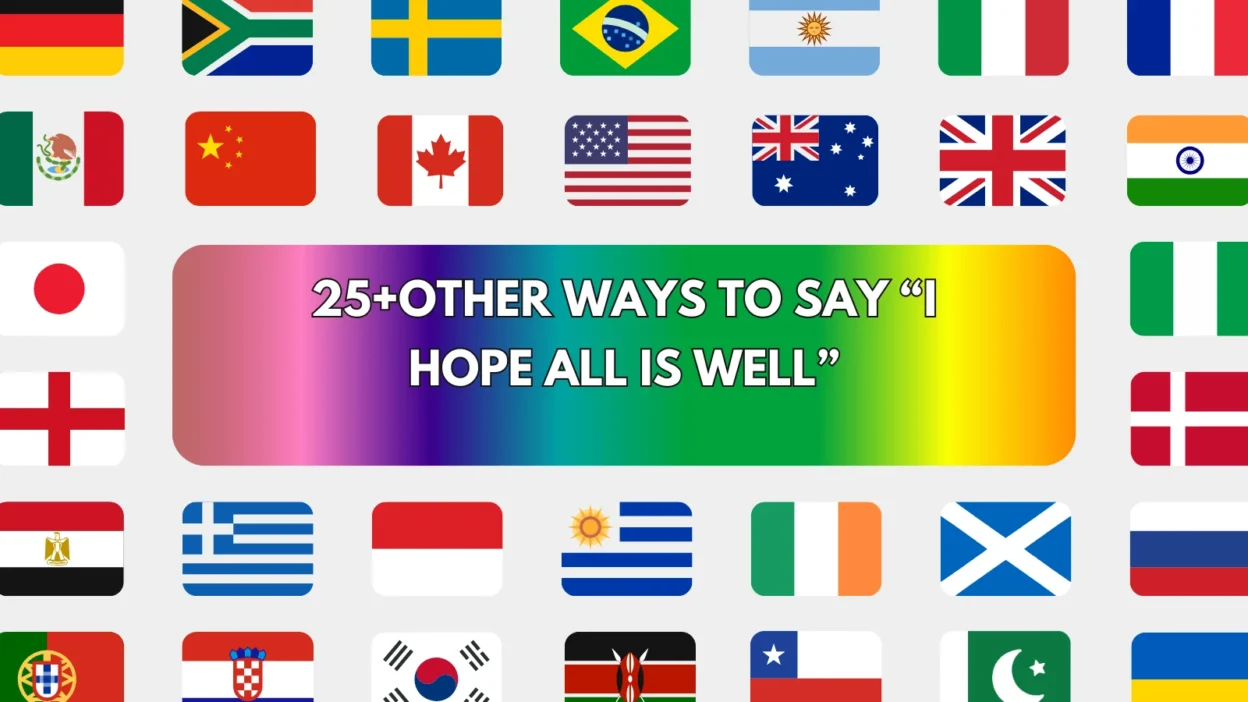The phrase “I hope all is well” is a common way to start emails and messages. It shows that you care about the recipient’s well-being while setting a friendly and professional tone. But because it’s used so often, it can feel repetitive or impersonal. That’s why having a variety of alternatives is helpful.
Below are 25 thoughtful and professional alternatives to say “I hope all is well,” each designed to fit different tones and situations — from formal business emails to warm check-ins.
1. I hope you’re doing well
Meaning:
Wishes the recipient is in a good state mentally and physically.
Detailed Explanation:
This is the closest variation to “I hope all is well,” but sounds a little more personal.
Scenario Example:
Hi Sarah, I hope you’re doing well. I wanted to follow up on our last discussion.
Best Use:
Professional and casual emails.
Tone:
Warm, neutral.
2. I trust you’re having a good week
Meaning:
Expresses faith that the recipient’s week is going positively.
Detailed Explanation:
Adds a time frame, making it more current and specific than the original phrase.
Scenario Example:
Good morning, I trust you’re having a good week. Just checking in on the report.
Best Use:
Work emails, weekly updates.
Tone:
Polite, upbeat.
3. I hope everything’s going smoothly
Meaning:
Wishes that things are progressing well for the recipient.
Detailed Explanation:
Good for when you’re aware the person may be busy or in the middle of something.
Scenario Example:
Hi Emily, I hope everything’s going smoothly with the launch.
Best Use:
Project check-ins, supportive messages.
Tone:
Caring, positive.
4. I hope you’ve been doing well
Meaning:
Covers a broader time period, often after a gap in communication.
Detailed Explanation:
Shows ongoing concern, not just for the current moment.
Scenario Example:
Hello Mark, I hope you’ve been doing well since we last spoke.
Best Use:
Reconnect emails, longer pauses in communication.
Tone:
Warm, thoughtful.
5. I hope this message finds you well
Meaning:
A traditional and polite way to express well-wishing.
Detailed Explanation:
More formal and timeless — works across industries.
Scenario Example:
Dear Mr. Singh, I hope this message finds you well. I’m writing about…
Best Use:
Formal business communication.
Tone:
Professional, respectful.
6. I hope you’re having a great day
Meaning:
Wishes someone a good day.
Detailed Explanation:
Casual and cheerful, great for upbeat or friendly messages.
Scenario Example:
Hi Jenna, I hope you’re having a great day so far!
Best Use:
Client relations, friendly chats.
Tone:
Positive, energetic.
7. I trust all is well on your end
Meaning:
Expresses trust that things are fine for the recipient.
Detailed Explanation:
Adds a slight formality and is especially common in business writing.
Scenario Example:
Dear Alex, I trust all is well on your end. I wanted to follow up on…
Best Use:
Business correspondence.
Tone:
Professional, composed.
8. I hope you’re staying safe and healthy
Meaning:
Wishes for the recipient’s health and well-being.
Detailed Explanation:
Ideal during difficult times or health-related contexts.
Scenario Example:
Hi Maria, I hope you’re staying safe and healthy during this season.
Best Use:
During global events, personal care.
Tone:
Caring, gentle.
9. I hope you’re enjoying the week so far
Meaning:
Wishes the recipient is having a good week.
Detailed Explanation:
A casual and engaging way to start an email.
Scenario Example:
Hello Tom, I hope you’re enjoying the week so far!
Best Use:
Friendly workplace messages.
Tone:
Light, casual.
10. I hope life’s treating you kindly
Meaning:
A kind, slightly poetic way of wishing someone well.
Detailed Explanation:
Very warm and personal — best when you have a closer connection.
Scenario Example:
Hi Claire, I hope life’s treating you kindly these days.
Best Use:
Close professional or friendly communication.
Tone:
Warm, thoughtful.
11. I hope all is good on your side
Meaning:
A friendly check-in on how things are going.
Detailed Explanation:
A relaxed and neutral phrase, appropriate for ongoing work.
Scenario Example:
Hi Peter, I hope all is good on your side. Any updates on the project?
Best Use:
Ongoing work or collaborations.
Tone:
Neutral, conversational.
12. I trust everything is going well
Meaning:
Confidently assumes the recipient is doing well.
Detailed Explanation:
Stronger than “I hope,” this implies positivity and stability.
Scenario Example:
Dear Olivia, I trust everything is going well with the team.
Best Use:
Senior-level or confident professional writing.
Tone:
Assured, professional.
13. I hope your week is off to a good start
Meaning:
Wishes a positive beginning to the recipient’s week.
Detailed Explanation:
Perfect for Monday or early-week emails.
Scenario Example:
Good morning, I hope your week is off to a good start!
Best Use:
Weekly check-ins, early week communication.
Tone:
Friendly, encouraging.
14. I hope things are going well with you
Meaning:
General concern and positivity toward the recipient.
Detailed Explanation:
Works well when you don’t know specifics about their current situation.
Scenario Example:
Hi Rachel, I hope things are going well with you.
Best Use:
Universal opening line.
Tone:
Polite, neutral.
15. I hope you’re having a productive week
Meaning:
Wishes the recipient success in their tasks.
Detailed Explanation:
Adds a touch of goal-oriented encouragement.
Scenario Example:
Hey Daniel, I hope you’re having a productive week.
Best Use:
Colleagues, work-related updates.
Tone:
Supportive, motivational.
16. I hope everything’s great with you
Meaning:
A casual, cheerful way of saying you care.
Detailed Explanation:
Feels natural and friendly, great for people you email often.
Scenario Example:
Hi Brian, I hope everything’s great with you!
Best Use:
Internal teams, long-term collaborators.
Tone:
Upbeat, friendly.
17. I hope you’re well and thriving
Meaning:
Wishes someone is doing more than just okay.
Detailed Explanation:
Communicates that you want the best for them — not just survival, but success.
Scenario Example:
Hi Ella, I hope you’re well and thriving.
Best Use:
Inspirational, supportive tones.
Tone:
Positive, empowering.
18. I hope you’ve had a great week so far
Meaning:
Recaps the week positively in your message.
Detailed Explanation:
Ideal for Thursday or Friday messages.
Scenario Example:
Hi Liam, I hope you’ve had a great week so far!
Best Use:
End-of-week check-ins.
Tone:
Friendly, light.
19. I trust you’ve been keeping well
Meaning:
A polished way of checking in on someone’s health or situation.
Detailed Explanation:
Adds formality and depth to a simple check-in.
Scenario Example:
Dear Mr. Ahmed, I trust you’ve been keeping well.
Best Use:
Formal emails, client relations.
Tone:
Refined, caring.
20. I hope this email finds you in good spirits
Meaning:
Wishes happiness and positivity to the recipient.
Detailed Explanation:
More emotional and expressive than basic phrases.
Scenario Example:
Hello Lauren, I hope this email finds you in good spirits.
Best Use:
Friendly and emotional messages.
Tone:
Sincere, personal.
21. I hope you’re staying positive
Meaning:
Encourages optimism and well-being.
Detailed Explanation:
Good during tough or uncertain times when reassurance helps.
Scenario Example:
Hi Kevin, I hope you’re staying positive through all the changes.
Best Use:
Supportive notes, emotional moments.
Tone:
Compassionate, kind.
22. I trust you’re doing okay
Meaning:
Checks in without overstepping or sounding too formal.
Detailed Explanation:
Good balance of concern and respect for personal space.
Scenario Example:
Hi Mia, I trust you’re doing okay and settling in.
Best Use:
Gentle follow-ups, changes or transitions.
Tone:
Caring, thoughtful.
23. I hope things have been good on your end
Meaning:
Acknowledges the time that’s passed and shows interest.
Detailed Explanation:
Suitable when there’s been a communication gap.
Scenario Example:
Hi Jake, I hope things have been good on your end.
Best Use:
Reconnecting emails.
Tone:
Warm, casual.
24. I hope your work is going well
Meaning:
Wishes smooth progress in the recipient’s job.
Detailed Explanation:
Professional and focused — best when talking about projects.
Scenario Example:
Hi Priya, I hope your work is going well and the launch is on track.
Best Use:
Team projects, work-focused conversations.
Tone:
Professional, supportive.
25. I hope you’re enjoying the season
Meaning:
Adds a timely, seasonal touch to a kind greeting.
Detailed Explanation:
Personalizes your message depending on the time of year.
Scenario Example:
Hi Zoe, I hope you’re enjoying the summer so far!
Best Use:
Seasonal greetings, light tone messages.
Tone:
Friendly, timely.
Conclusion
Saying “I hope all is well” is a great way to begin a message, but switching it up can show more thought and connection. Whether you’re emailing a client, friend, or coworker, these 25 variations help you match your tone, timing, and intent perfectly.




